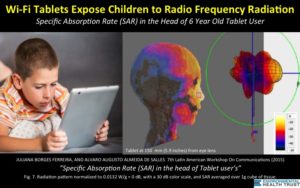France’s National Health And Safety Agency Calls For Reducing Children’s Wireless Exposures: ANSES 2016 Report
France’s National Health Agency Calls For Reducing Children’s Wireless Exposures
The National Agency of Health Security of Food, Environment and Labour Report All wireless devices, from tablets, remote controlled toys, wireless toys, baby monitors, and cell phones should be subjected to tighter regulatory limits.
 On July 8, the French National Agency of Health Security of Food, Environment and Labour (ANSES) published a new scientific report “Radiofrequency Exposure and the Health of Children”.
On July 8, the French National Agency of Health Security of Food, Environment and Labour (ANSES) published a new scientific report “Radiofrequency Exposure and the Health of Children”.
Concluding that children are more vulnerable to radio frequency (RF) wireless exposures, the French report recommends immediately reducing exposures to wireless radiation from all wireless devices for young children. Acknowledging the inadequacies of current outdated RF regulations, ANSES recommends strengthening RF exposure limits with child protective safety margins and developing more sophisticated premarket test methods to fully assess human exposures to RF radiation from wireless devices. The new report has made headlines across the country.
Report States Children Exposed More and Early
“Unlike previous generations, children are exposed today to multiple RF sources at a young age…Children are not miniature adults…because of their smaller size, their anatomical and morphological characteristics and the characteristics of some of their tissues, they are more exposed. In particular, the peripheral areas of their brains are more vulnerable than adults to RF.”
 This French national report affirms recent EHT publications showing greater absorption and vulnerability of the young to cell phone radiation. IEEE/Access: Dosimetric Simulations of Brain Absorption of Mobile Phone Radiation: the relationship between psSAR and age.
This French national report affirms recent EHT publications showing greater absorption and vulnerability of the young to cell phone radiation. IEEE/Access: Dosimetric Simulations of Brain Absorption of Mobile Phone Radiation: the relationship between psSAR and age.Recommendations of the Agency
The government agency recommends to “reconsider the regulatory exposure limits” to ensure “sufficiently large safety margins” to protect the health of young children:
- All wireless devices, including tablets, cordless phones, remote controlled toys, wireless toys, baby monitors and surveillance bracelets, should be subjected to the same regulatory obligations as cell phones.
- Compliance with regulatory exposure limits should be insured for the ways that devices are customarily used, such as positioned in contact with the body.
- Exposure limits for radiofrequency electromagnetic fields should be tightened to ensure sufficiently large safety margins to protect the health and safety of the general population, particularly the health and safety of children.
- Reliance on the specific absorption rate (SAR) to set human exposure limits should be re-evaluated and replaced through the development of an indicator to assess real exposures for mobile phone users that applies to various conditions: signal type, good or bad reception, mode of use (call, data loading, etc.), location device is used on the body.
- ANSES reiterated its recommendation, as previously stated, to reduce exposure to children: minimize use and prefer a hands-free kit.
Scientific Research Substantiates France’s Expert Recommendations
 “For several decades, my research and that of many others has shown that children and smaller adults will absorb relatively more radiation from mobile devices. Unfortunately, proper research on long term use has not been done to determine the full health impacts on children. I am one of many researchers who strongly recommend strengthening current regulations to protect children,” stated EHT advisor Om Gandhi of the Department of Electrical and Computer Engineering, University of Utah, who has published multiple research studies indicating that children absorb radiation deeper into their brains than adults.
“For several decades, my research and that of many others has shown that children and smaller adults will absorb relatively more radiation from mobile devices. Unfortunately, proper research on long term use has not been done to determine the full health impacts on children. I am one of many researchers who strongly recommend strengthening current regulations to protect children,” stated EHT advisor Om Gandhi of the Department of Electrical and Computer Engineering, University of Utah, who has published multiple research studies indicating that children absorb radiation deeper into their brains than adults.
“Coming on the heels of the U.S. government study showing increased risks of rare tumors of the brain and heart tied with wireless radiation in rats, this new French government report provides a welcome reminder of the importance of protecting young brains and bodies. The absence of proof of harm in our children at this time should not be confused with evidence of safety,” added Devra Davis PhD MPH, FACE, Visiting Professor of Medicine, The Hebrew University and President of Environmental Health Trust. “We cannot afford to treat the young as subjects in an experiment for which we will soon have no unexposed control group,” she added.
“Our published research on cell phones but also tablets and laptops indicates that equivalent exposures to radio frequency results in different doses to specific tissues in children compared with adults. The wireless device certification process should be complemented with a computer simulation process using anatomically based models of different ages,” stated Professors Claudio Fernandez and Alvaro de Salles, EHT Advisors from the Electrical Engineering Departments of the Federal Institute and University of Rio Grande do Sul, IFRS and UFRGS, Brazil.
Over Twenty Governments Have Enacted Protective Policy
 France previously enacted highly protective laws in regards to radiofrequency exposures. Wi-Fi is banned in kindergarten and OFF is the default setting in elementary schools (unless if specific classroom instruction requires it during certain time periods). French national law also addresses cell tower emissions compliance and labels Wi-Fi transmitters in public spaces. French cell phone legislation bans cell phones for young children, mandates SAR labeling, and requires that all cell phones are sold with headsets. This new report calls for tightening regulations even further in light of findings that children experiences serious learning and other problems tied with wireless exposures. Over twenty countries and governments have enacted various protective policies to reduce radiofrequency exposure to children.
France previously enacted highly protective laws in regards to radiofrequency exposures. Wi-Fi is banned in kindergarten and OFF is the default setting in elementary schools (unless if specific classroom instruction requires it during certain time periods). French national law also addresses cell tower emissions compliance and labels Wi-Fi transmitters in public spaces. French cell phone legislation bans cell phones for young children, mandates SAR labeling, and requires that all cell phones are sold with headsets. This new report calls for tightening regulations even further in light of findings that children experiences serious learning and other problems tied with wireless exposures. Over twenty countries and governments have enacted various protective policies to reduce radiofrequency exposure to children.
ANSES also called for more research evaluating the health and psychosocial impact (academic learning, social and family relationships, etc.) in children, related to the use of mobile communication technologies, particularly because of addictive phenomena, disorders in circadian rhythms, etc. The Agency advises parents “to minimize their children’s mobile phone use, avoid nighttime communications and reduce the frequency and duration of calls”.
No comments:
Post a Comment